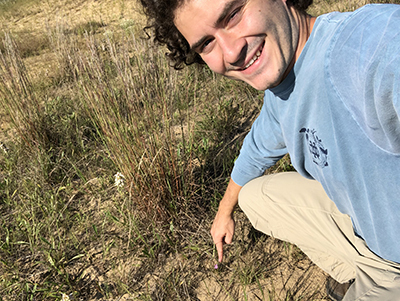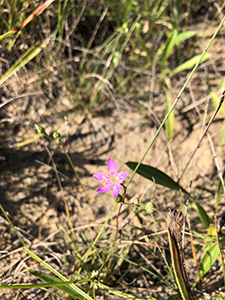
For many students in the sustainability minor, the coronavirus pandemic threw a wrench in their capstone projects. But because of his unique interest in botany, Michael Piotrowski could carry on with his plans. One of the few students in the program able to do field research in the summer of 2020, the senior environmental science major tracked the elusive rough-seeded fameflower (Phemeranthus rugospermus) across Indiana.
Piotrowski received the initial inspiration for his project from botanist and environmental consultant Nathanael Pilla, who co-taught his fall 2019 local flora course along with Rachel Novick, director of the minor in sustainability and associate professor of the practice in biology. Pilla suggested that Piotrowski help the Indiana Department of Natural Resources create conservation status reports and introduced him to Indiana DNR botanist Scott Namestnik, who helped Piotrowski pick out the fameflower as the focus of his capstone project.

Indiana records on the fameflower date back to the 1920s, but botanists have only recorded it growing in eighteen locations in the state. For his project, Piotrowski visited as many of these sites as possible to investigate whether they still serve as habitats for the rare rough-seeded fameflower.
“It really filled every niche I hoped it would,” Piotrowski said of this field-based capstone project. “I could tie in caring about the environment [and] caring about plants together really well, and [it would] give me skills I wasn’t getting through classes.”
Out of the over a dozen sites he visited, Piotrowski only spotted the rough-seeded fameflower in three locations. ‘I was shocked to only see it a handful of times, but I was also really happy that I saw it at all,” he said.
In fact, the few instances in which Piotrowski did see the plant made this capstone project one of his “absolute favorite experiences at Notre Dame.” Piotrowski made his first sighting himself during a masked and socially-distanced hike with Namestnik. “I got so excited, I couldn’t believe my eyes,” Piotrowski explained.
Piotrowski's research was possible during the pandemic, because he could complete most of his field work alone. But this largely solitary project did not prevent him from making valuable connections with experts like Namestnik across Indiana.
“[Piotrowski] partnered with several local botanists and the state Department of Natural Resources to identify the plant he would study and the field locations,” Novick explained. “[His] project was a great example of regional cooperation.”
Although Piotrowski’s research benefited from the relationships he built in the field, he knows that it will take more than just collaboration among botanists to save the fameflower. The plant crops up only in sandy, cleared areas of the forest, so it has never been very common. But Piotrowski’s study provides evidence that the fameflower’s numbers are decreasing.
While each individual might not make an enormous impact on the rough-seeded fameflower’s survival, cooperative strategies like better forest management can give it a more suitable habitat. “What we can do as a society is pay more attention to how to live with nature better,” Piotrowski explained.
Admittedly, the rough-seeded fameflower makes few concrete contributions to human society or industry. Nevertheless, the plant still matters. “If you can care about something that really doesn’t have any economic value, purely because you know that protecting biodiversity is protecting the entire food web and all life on the planet, then we’re a better society because of it,” Piotrowski said.
Furthermore, as Piotrowski’s capstone project showed him, there is so much more to discover about the rough-seeded fameflower. “Who knows what this plant could be good for?” Piotrowski asked. “If it disappears without us ever learning anything about it, then that’s a total missed opportunity.”